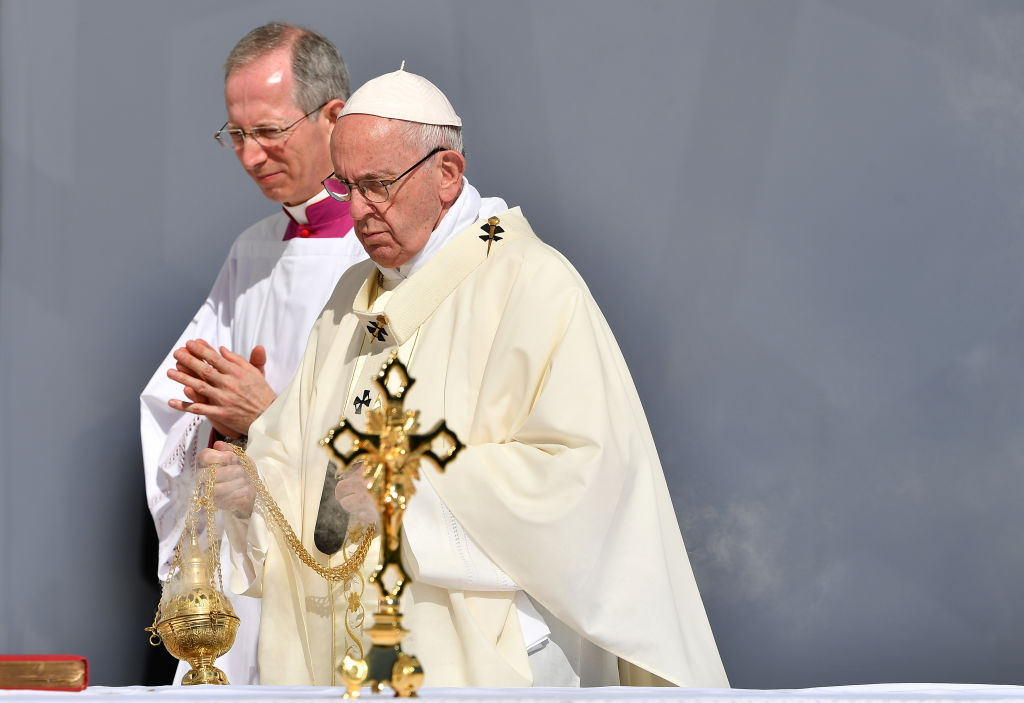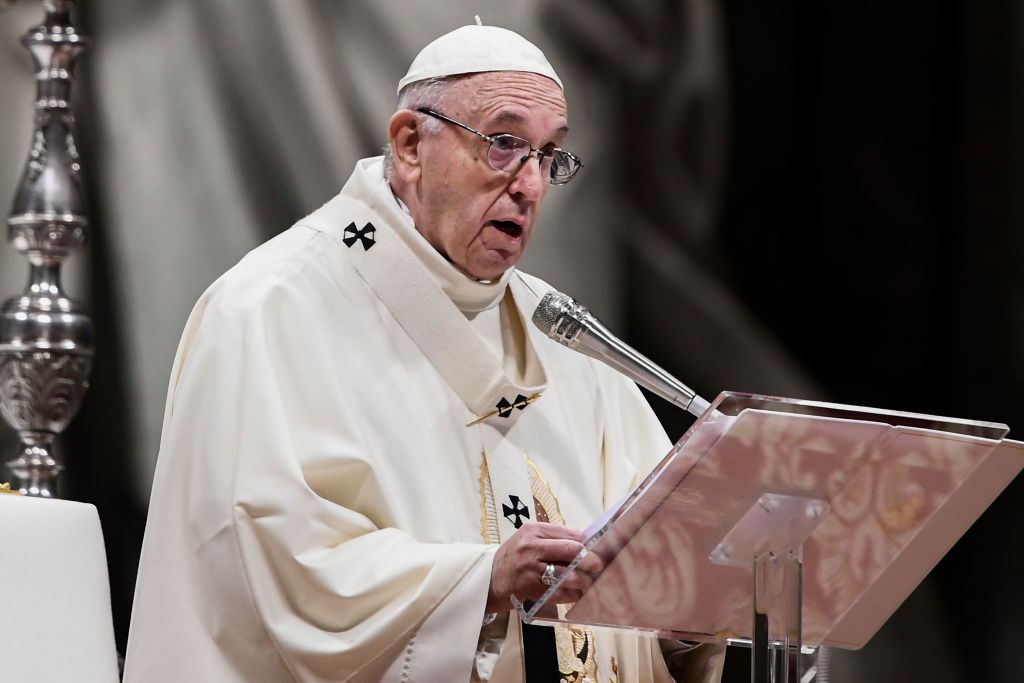The unbearable ugliness of the Catholic Church
It has been revealed as a repulsive institution. I'm done.


How will the Roman Catholic Church survive the scandals engulfing it on every side?
It's a hyperbolic question, but one with a serious intent.
Of course the church will continue to exist in some form. Two-thousand-year-old institutions with a billion adherents and solid growth rates in the developing world don't disappear overnight, no matter how thoroughly corrupt they are revealed to be.
The Week
Escape your echo chamber. Get the facts behind the news, plus analysis from multiple perspectives.

Sign up for The Week's Free Newsletters
From our morning news briefing to a weekly Good News Newsletter, get the best of The Week delivered directly to your inbox.
From our morning news briefing to a weekly Good News Newsletter, get the best of The Week delivered directly to your inbox.
But in what form will it survive?
Four decades ago, Ireland was among the most homogeneously and fervently Catholic countries in the world. When Pope John Paul II visited in 1979, he was greeted by crowds of well over a million people. Last weekend, three months after the overwhelming passage of a referendum that repealed the pro-life provision of the Irish constitution, Pope Francis addressed a crowd roughly one-tenth the size.
What has changed? In the intervening years, Irish Catholicism has been crushed by an avalanche of scandals involving the widespread decades-long abuse (sexual and otherwise) of children in the country's schools and childcare system.
Over the past few decades, similar scandals have been exposed in countries around the world. In most cases, clerics of various rank have been credibly accused of abusing (usually but not always male) children and teenagers, and of breaking celibacy vows with seminarians and others over whom they serve in positions of authority. When such acts have been brought to the attention of those higher up the church hierarchy, the accused have rarely been punished, often moved to new dioceses (where they have frequently repeated the behavior), and sometimes promoted to positions of great power and influence in the church.
A free daily email with the biggest news stories of the day – and the best features from TheWeek.com
The pattern has been repeated over and over and over again. Early in the 2000s, one wave of scandal crashed over the American church with allegations of abuse and cover-up roiling dioceses across the country, with the Archdiocese of Boston, overseen by the formidable Archbishop Cardinal Bernard Francis Law, hit especially hard. One priest in Boston allegedly raped or molested 130 children as church officials moved him from parish to parish over decades. In the end, a total of 271 members of the clergy were publicly accused of child sex abuse in Boston alone.
Sixteen years and roughly $3 billion in financial settlements later, the scandal is back. This time its focal point is Theodore McCarrick, the former archbishop of Washington, D.C. — a man who had been promoted to top positions in the church despite being credibly and repeatedly accused of a range of acts of sexual predation, including the years-long abuse of a boy (whom McCarrick had reportedly baptized as a baby) starting when he was 11 years old.
As if to underscore that the problem goes far beyond a single wayward prelate, the revelations about McCarrick, which broke in mid-July, were quickly followed by the release of an exhaustive (1,400-page) grand jury report that identified 1,000 cases of childhood sexual abuse at the hands of more than 300 Catholic priests in the single state of Pennsylvania (where I live with my wife and children). Other states are apparently preparing similar reports of their own.
Here is a summary from The Washington Post of a tiny sliver of what one will find in the report's squalid and scummy pages:
In Erie, a 7-year-old boy was sexually abused by a priest who then told him he should go to confession and confess his "sins" to that same priest.Another boy was repeatedly raped from ages 13 to 15 by a priest who bore down so hard on the boy's back that it caused severe spine injuries. He became addicted to painkillers and later died of an overdose.One victim in Pittsburgh was forced to pose naked as Christ on the cross while priests photographed him with a Polaroid camera. Priests gave the boy and others gold cross necklaces to mark them as being "groomed" for abuse. [The Washington Post]
Finally — for now — there's the astonishing memo by Archbishop Carlo Maria Viganò that was published over the weekend, alleging that numerous high-ranking church officials, including Pope Francis himself, knew about McCarrick's record of abuse for many years and yet repeatedly promoted and protected him from sanctions (including those imposed by Pope Benedict XIV).
The most common response among church watchers to this utterly sordid display has been to render moral judgment and then assimilate the facts — priests abused kids; bishops covered up for it — into pre-existing ideological storylines. So conservatives blame a culture of homosexuality in the church that needs to be rooted out once and for all in favor of a stricter adherence to long-standing teachings about human sexuality. Liberals, for their part, think the problem is a culture of clericalism and hypocrisy bred by cruel, sexually stultifying rules that need to be reformed in the direction of tolerance and acceptance.
Both sides have a point, but both sides utterly fail to grasp the gravity of what's happening right before our eyes. Church attendance has been in sharp decline for a lot longer than 16 years. The number of young Catholics choosing to become priests and nuns has been shrinking even faster. According to polls, an astonishing 98 percent of Catholics in the U.S. reject the church's teaching on contraception. Catholic women are just as likely as non-Catholic women to have an abortion, while Catholics as a whole are more likely than the average American to support same-sex marriage.
And now this tsunami of scandal? A decade and a half after Cardinal Law resigned in disgrace (only to be given a compensatory luxurious sinecure at the Vatican)? Does anyone seriously believe those pews won't be far, far emptier a decade from now, once the remaining parishioners absorb the reality that a church hierarchy that gets off on wagging its crooked little finger at the behavior of lay Catholics behaves behind closed doors as if it considers those impossibly stringent teachings to be a colossal joke?
The core of the church's problem isn't personal immorality, or institutional corruption, or hypocrisy. The core of the problem is ugliness.
People too often fail to appreciate the role of beauty in religion. We point to revelatory experiences — a supposed eruption of the divine into the realm of the profane or an apparition that communicates a personal message of salvation. Or we highlight a vision of moral righteousness or purity that draws us toward a life of piety.
But there is also the beautiful — in the sense of seemliness, order, and proportion, but also elevation, nobility, and exaltation. My friend Rod Dreher writes movingly about how he was originally drawn toward Christianity by a visit as a young man to Chartres Cathedral in France, one of the most stunning religious structures ever built. Standing before and within this astonishing monument to God, Dreher for the first time felt the presence of the divine in the world and in his life. For him, the building was a powerful testament to the truth of the Christian message.
The singular importance of beauty or nobility to the most profound moral and religious experience was noted centuries before Christ in the dialogues of Plato, where the character of Socrates frequently asks his interlocutors searching questions about elevation. What do we admire? What acts stir us and move us to tears? Often it is those acts involving self-sacrifice, devotion to something loftier, something purportedly higher. In the secular sphere, this is something John McCain understood very well: By serving something higher than ourselves, and by devoting ourselves to it selflessly, we elevate ourselves, lifting ourselves up in the direction of eternity. (In McCain's vision of fervent American patriotism, this something was an ideal vision of the United States.)
When I converted to the Catholic Church 18 years ago, I did so in large part because I was deeply moved by the act of self-sacrifice that the church places at its heart. God sacrifices his beloved son, and his son freely accepts that sacrifice, out of self-giving love for humanity. Out of that breathtakingly beautiful gesture, the church built a new civilization founded on a message of forgiveness of sins, of care for the poor, of beatitude, of salvation and eternal life for all.
Of course the history of the church is filled with imperfection, of violence, of all-too-human sin and corruption. But monuments to the church's message were everywhere to behold: art and architecture, an intellectual tradition, a comprehensive moral and eschatological vision of all things from first to last, a politics founded on a belief in the equal dignity of all. If I didn't really believe in all of the theological precepts taught by the church, at least I wanted to — because I considered them beautiful, and because I wanted to be a part of the beauty, to elevate myself by assimilating myself to it.
That impulse seems very far away from me now. It began to fade in the church scandals that broke less than two years after I entered the church. The crisis deepened by working for a devout priest who responded to the scandals by circling the wagons against the secular press and its impertinent reporters looking to harm the church with their pesky attachment to uncovering the truth.
My belief has faded further over the intervening years, as I've tried to keep some spark of it alive long enough to give my children the Catholic education that from the moment of my conversion I was obligated to provide them. I fulfilled that duty — and now all I can say is that I'm so grateful that my son and daughter escaped the church without suffering the fate of 300 of their fellow Pennsylvanians.
The world can be a dangerous place. My kids could be abused and violated anywhere. I'm not a helicopter parent out to protect them from any and all risk. But to wade through the toxic sludge of the grand jury report; to follow the story of Theodore McCarrick's loathsome character and career; to confront the allegations piled up in Viganò's memo — it is to come face to face with monstrous, grotesque ugliness. It is to see the Catholic Church as a repulsive institution — or at least one permeated by repulsive human beings who reward one another for repulsive acts, all the while deigning to lecture the world about its sin.
No thanks. I'm done.
And I bet I'll have a lot of company headed for the door.
Damon Linker is a senior correspondent at TheWeek.com. He is also a former contributing editor at The New Republic and the author of The Theocons and The Religious Test.
-
 The Week’s big New Year’s Day quiz 2026
The Week’s big New Year’s Day quiz 2026Quiz of the Year How much do you remember about 2025’s headlines? Put yourself to the test with our bumper quiz of the year
-
 Is tanking ruining sports?
Is tanking ruining sports?Today's Big Question The NBA and the NFL want teams to compete to win. What happens if they decide not to?
-
 ‘Netflix needs to not just swallow HBO but also emulate it’
‘Netflix needs to not just swallow HBO but also emulate it’instant opinion Opinion, comment and editorials of the day
-
 Pope Francis speaks about sex abuse scandals, Trump, and his conservatism
Pope Francis speaks about sex abuse scandals, Trump, and his conservatismSpeed Read
-
 Pope Francis makes unprecedented decision in defrocking Theodore McCarrick
Pope Francis makes unprecedented decision in defrocking Theodore McCarrickSpeed Read
-
 For the first time, Pope Francis publicly admits priests and bishops have sexually abused nuns
For the first time, Pope Francis publicly admits priests and bishops have sexually abused nunsSpeed Read
-
 Pope Francis calls for peace in Yemen
Pope Francis calls for peace in YemenSpeed Read
-
 Pope Francis to abusive priests: 'Hand yourself over to human justice'
Pope Francis to abusive priests: 'Hand yourself over to human justice'Speed Read
-
 Pope Francis accepts resignation of embattled Washington Archbishop Donald Wuerl
Pope Francis accepts resignation of embattled Washington Archbishop Donald WuerlSpeed Read
-
 Pope Francis defrocks Chilean priest over sex abuse scandal
Pope Francis defrocks Chilean priest over sex abuse scandalSpeed Read
-
 Pope Francis will meet with U.S. church leaders over clergy abuse
Pope Francis will meet with U.S. church leaders over clergy abuseSpeed Read
